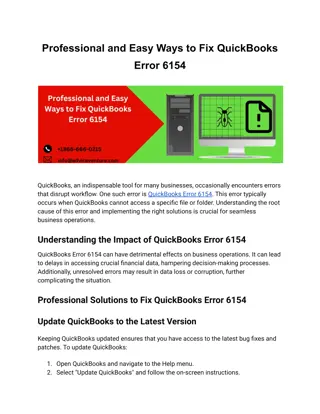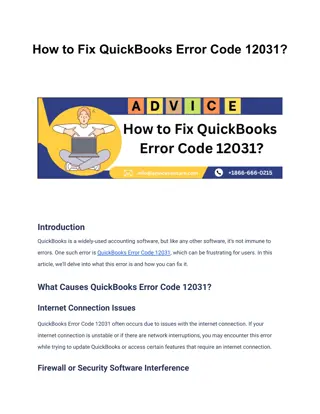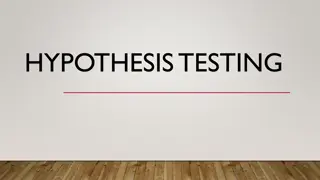Understanding Error Analysis in Education
Error analysis in education involves identifying, categorizing, and addressing errors made by learners to improve understanding. It includes types of errors, differences between error and mistake, linguistic errors, and different schools of thought regarding error correction in teaching methods.
Download Presentation

Please find below an Image/Link to download the presentation.
The content on the website is provided AS IS for your information and personal use only. It may not be sold, licensed, or shared on other websites without obtaining consent from the author. Download presentation by click this link. If you encounter any issues during the download, it is possible that the publisher has removed the file from their server.
E N D
Presentation Transcript
Test Development and Evaluation Semester: 8 Dr. Uzma Dayan
Topic: ERROR ANALYSIS (EA)
Learning Targets By the end of the lesson, students will be able to: Identify nature and kinds of Error. Examine possible causes of students conceptual errors. Suggest ways to address students conceptual errors.
What is Error Analysis? Error analysis is a method used to document the errors that appear in learner work (home work, test, assignment). It determines whether those errors are systematic, and (if possible) explains what caused them. It also presents remedial plan.
Definition of EA Error analysis is a systematic deviation that happens when a learner has not learnt something, and consistently gets it wrong. (Norrish, 1983)
Types of Errors Generally, there are three types of errors: 1. Conceptual 2. Factual 3. procedural
Difference between error and 'mistake Mistake A 'mistake' is usually accidental, you know it is wrong. Mistakes could be self-corrected Mistakes are not systematic Error an 'error' is usually made due to the lack of knowledge and are more formal. Errors are systematic
Linguistic Errors In Linguistics, An error is the use of a word, speech or grammatical item in such a way it seems imperfect and significant of an incomplete learning (J. Richard et al., (2002). Errors are signals that indicate an actual learning process taking place and that the learner has not yet mastered or shown a well-structured competence in the target language (Hendrickson, 1987).
Schools of thought First School of thought: linked the errors commitment with the teaching method arguing that if the teaching method was adequate, the errors would not be committed (Corder 1967) . Second school of thought: believed that we live in an imperfect world and that errors correction is something real and the applied linguist cannot do without it no matter what teaching approach they may use.
Background In 1950, Contrastive Approach cause of committing errors in the process of second language learning is: The L1; the linguistic background of the language learners badly affects the production in the target language. Mother tongue interference (Anefnaf Z. 2017; X. Fang and J. Xue-mei 2007) .
contd. In 1960, Contrastive approach was replaced by Error Analysis. It was influenced by behaviorism. Claim: CA was only effective in Phonology (the study of sound) EA developed as a branch of Linguistics in the 1960s and it came to light to argue that the mother tongue was not the main and the only source of the errors committed by the learners (J. Richard et al. 2002)
Contd. Errors can be caused by the target language itself and by the applied communicative strategies as well as the type and quality of the second language instructions (Hashim,1999).
Aims of Error Analysis (Linguistics) To identify strategies which learners use in language learning, in terms of the approaches and strategies used in both of teaching and learning. To identify the causes of learners errors, that is, investigating the motives behind committing such errors as the first attempt to eradicate them. To obtain information on common difficulties in Language Learning, as an aid to teaching or in the preparation of the teaching materials (J. Richard et al. 2002).
Major causes of Errors Interlingual Intralingual an error made by the Learner s Linguistic background and Native language interference. error committed by the learners when they misuse some Target Language rules is caused by the interference of the native language takes place due to a particular misuse of a particular rule of the target language. regular and irregular verbs, plural forms. E.g. (Tooth == Tooths) (He goed)
Classification of Errors on the basis of Basic types on the basis of Appearance On the basis of Level of language Omissive, Additive, Substitutive Overt (e.g. I angry ) Covert (evident in the context) phonological errors, vocabulary or lexical errors, syntactic errors
Examples of omissive errors Spelling: omission of silent letters: no (know) dout (doubt) weit (weight) Grammar: omission of We wait the bus all the time
Examples of Syntax Errors Syntax is the arrangement of words in a sentence Incorrect: While watching a movie, people who text on their phone are very annoying. Correct: People who text on their phone while watching a movie are very annoying. Incorrect: To the movies we are going. Correct: We are going to the movies.
Examples of Lexical Errors Lexical: use of words in terms of meaning. Lexical errors means words which were not used appropriately in terms of meaning. Lexical error: I took a drink of an apple. Correction: I took a bite of an apple. Lexical error: I did a bite of an apple. Correction: I took a bite of an apple.
Examples of Additive errors Addition: Students are do their researches every semester . Both the boys and the girls they can study together.
Examples of Substitutive Errors 'thun' for 'sun. My tennis racket , my tennis bat Set the chair , set the table
other type of Errors Developmental Errors this kind of errors is somehow part of the overgeneralizations, D.E are results of normal pattern of development, such as (come = comed) (break = breaked), D.E indicates that the learner has started developing their linguistic knowledge and fail to reproduce the rules they have lately been exposed to in target language learning.
Contd. Induced errors: known as transfer of training, errors caused by misleading teaching examples, teachers, sometimes, unconditionally, explain a rule without highlighting the exceptions or the intended message they would want to convey (J. Richard et al. 2002).
Example of Induced Error teaching prepositions particularly at where the teacher may hold up a box and say I am looking at the box , the students may understand that at means under , they may later utter the cat is at the table instead of the cat is under the table. (J. Richard et al. 2002)
Contd. Errors of avoidance: these errors occur when the learner fail to apply certain target language rules just because they are thought of to be too difficult.
Reflection Time Errors are significant for Teachers Learners How? One point from each student
Conclusion Teaching is a highly reflective and moral responsibility. Assessment has a significant role to make teaching and learning meaningful. Students work is a source of getting knowledge about them that ultimately helps them improving their learning.























